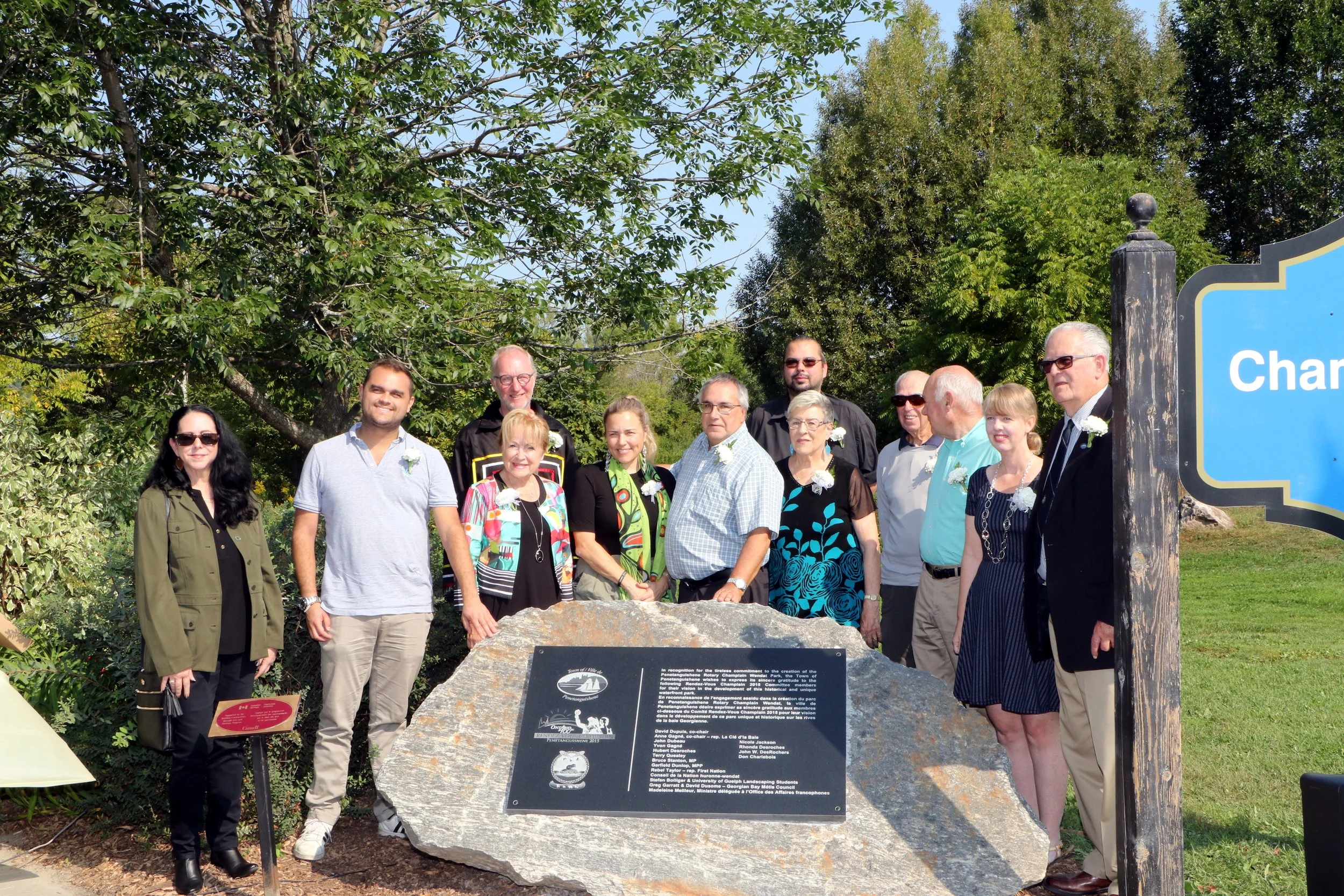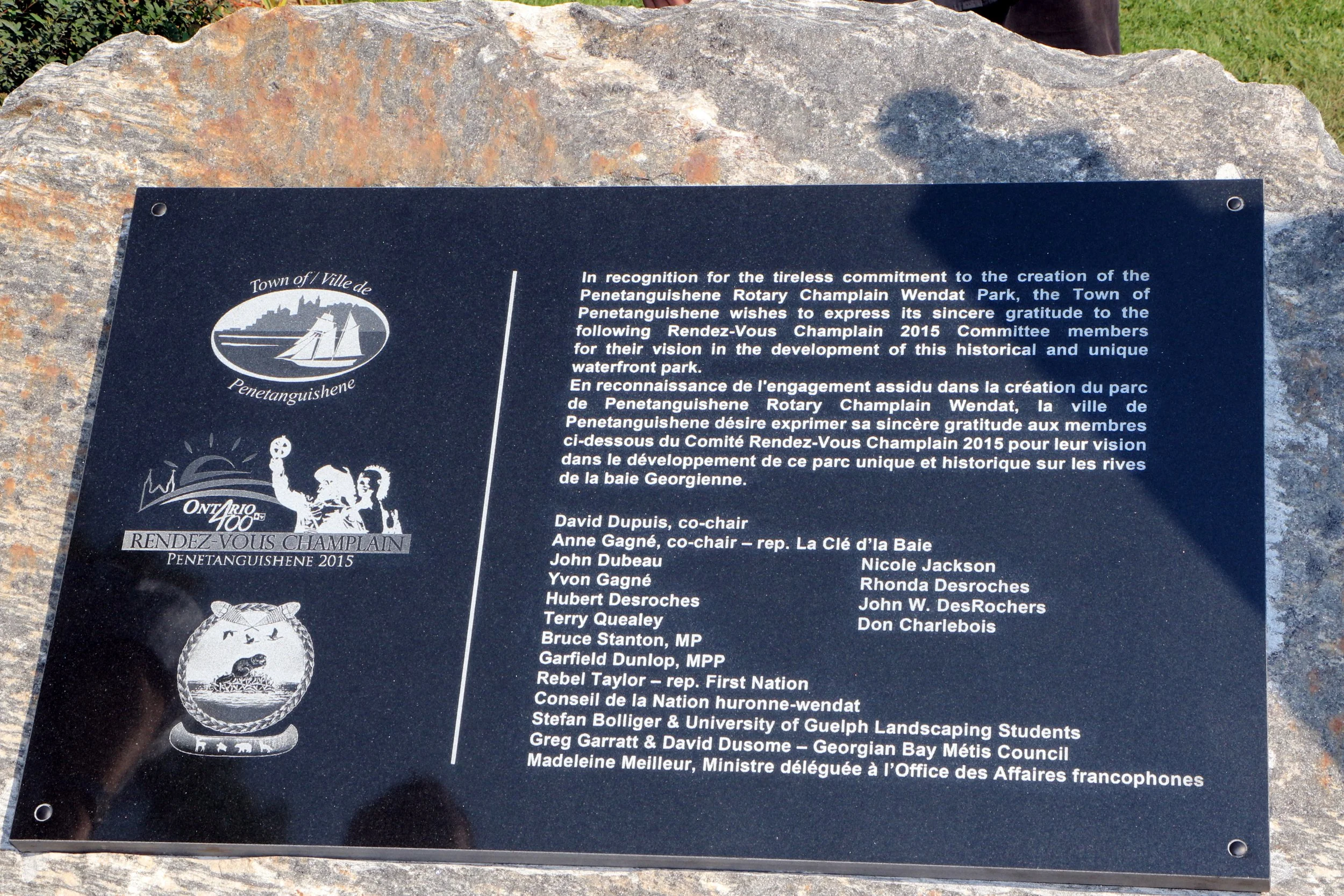Penetanguishene’s Rotary Champlain Huron-Wendat Park: A Place of Beauty, History, Peace and Reconciliation
Representatives of the Huron-Wendat Nation gather with family representatives, the Hon. Madeleine Meilleurs, and members of the 2015 Rendezvous Champlain committee, and Penetanguishene Mayor Doug Leroux, at the unveiling.
The newly unveiled 2015 Rendezvous Champlain Committee plaque
We’ve all experienced a moment when speaking to someone or about something important, when we said afterwards, “Gosh, I wish I’d said or I forgot to say this or that!” That happened to me in a big way!
Yesterday, the Town of Penetanguishene graciously dedicated a plaque recognizing the efforts of our 2015 Rendezvous Champlain committee and partners, in planning the historical Rotary Champlain Huron-Wendat Park. And we thank the town profusely for the honour. It was an amazing and historical day. As one of two co-chairs of the committee, I made a speech along with my sister and co-chair Anne Gagne, thanking everyone involved. I didn’t want to miss anyone. But I forgot to talk about the most important aspect of the park. I do so now.
From the outset in planning the park as early as 2005, we wanted to, yes, recognize the 400th anniversary in 2015 of Champlain landing in Penetanguishene Bay. But this time, we wanted a revitalized park to equally recognize the importance of the Huron-Wendat Nation who brought him here to these shores at the ancient Wendat village of Toanche.
From the very first phone call, we had the cooperation and total respect and support of the Huron-Wendat Nation from Wendake, Quebec. There was no hesitation. They saw immediately that our plans for the park wanted to include them, to pay homage as equals, as Champlain did. Champlain had great respect for them. We did too. Our plans materialized together and with their total and glowing support, we acquired the funds to make our revitalized park a reality.
The results speak for themselves besides the park’s name: the large main statue of Champlain and Chief Aenons on McGibbon Point depicts them as looking eye-to-eye, holding together a wampum belt, as equals. This is a first for a Champlain statue in North America. A large 30 foot steel canoe is nearby at the water’s edge. Various statues depicting the Wendat’s “three sisters,” and the Wendat people line the Legacy Walkway. Also nearby is a small depiction of a frame of a Wendat longhouse and a large patio area with a circle of four large stones recognizing the four main clans of the Huron-Wendat in this region in Champlain’s time: Cord, Rock, Bear, and Deer. The Bear clan occupied northern Tiny Township and greeted Champlain at Toanche.
Elements that did not get included but were planned for the park were: a large Huron-Wendat native arboretum, a very large longhouse and a vary large stone turtle. Maybe in the future. As they left yesterday to head back to Quebec, the Huron-Wendat told me, “If you need anything from us, just call! We are with you and we’ll be here with our total support in any way that we can. We are your friends.”
With the residential school’s situation across Canada brewing, troubles and irreconcilable differences at the famous Champlain monument in nearby Orillia, and Truth and Reconciliation issues being dominant across Canada, we did things right here in Penetanguishene. We spoke with the Huron-Wendat from the beginning and planned it together. We were on the same page.
Rotary Champlain Huron-Wendat Park, yesterday and always, is a shining example of what respect and reconciliation with First Nations can look like. We are “friends.” We are equals. We are brothers and sisters. That never wavered. We on our committee are very proud of that. Penetanguishene should be too.
That’s what I meant to say yesterday!


